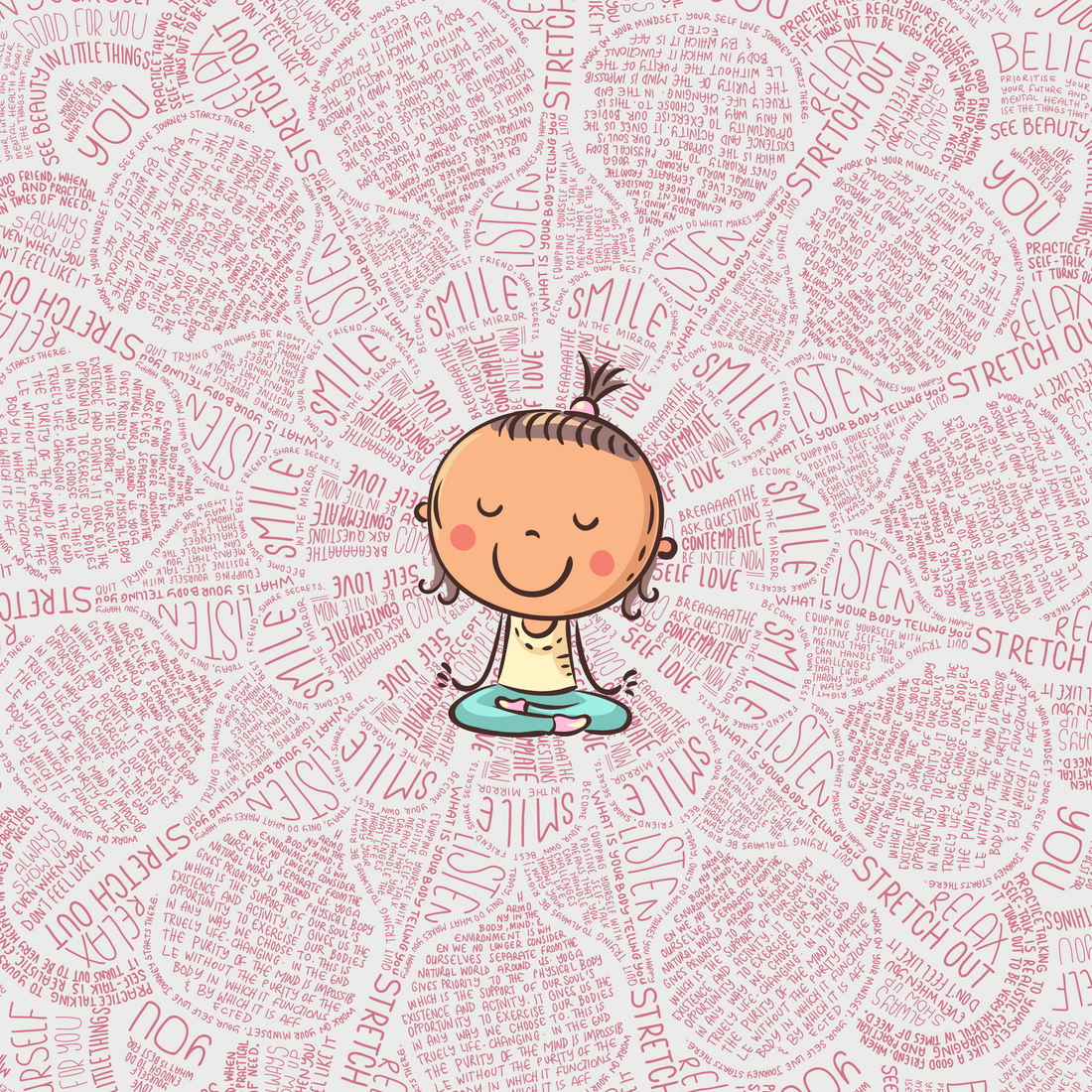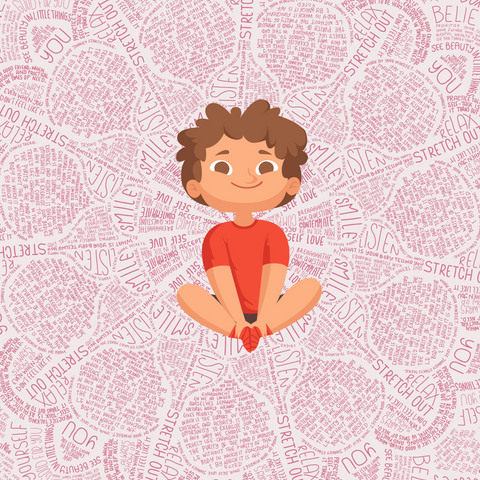Introducing meditation for kids can be a transformative experience, offering numerous benefits to their overall well-being and development. As mindfulness practices continue to gain popularity among adults, it's essential not to overlook the potential impact on young minds. In this comprehensive blog post, we will delve into the world of meditation for kids and explore its many advantages.
Exploring the potential gains from meditation for kids, this blog post will look into enhanced focus, lowered tension and worry levels, plus augmented self-awareness that may come with it. Next, we'll provide guidance on how to introduce your child to mindfulness meditation through engaging activities that cater specifically to their age group.
Furthermore, you'll discover practical tips for creating an ideal environment conducive to teaching mindfulness effectively while keeping the sessions enjoyable. Lastly, we will address common questions parents may have about incorporating mindfulness training into their child's routine – including safety concerns and age-appropriate recommendations – before sharing creative ways you can seamlessly integrate these practices into daily life.
Embarking on this journey together with your child promises a myriad of rewards that extend beyond mere relaxation; join us as we unlock the door towards a more mindful future for our youth.
Table of Contents:
- Benefits of Meditation for Kids
- How to Introduce Meditation to Kids
- Tips for Practicing Meditation with Kids
- Common Questions About Meditation for Kids
- 5 Creative Ways to Incorporate Meditation into Your Child's Routine
- FAQs in Relation to Meditation for Kids
- Conclusion
1. Benefits of Meditation for Kids
Meditation is not just for adults; kids can also reap numerous benefits from this ancient practice. In this modern era, kids are often exposed to tension and unease, so it is essential to teach them strategies for dealing with these feelings such as meditation. Let's dive into some of the fantastic advantages that meditation offers our little ones.
a. Improved Concentration
Kids have a natural curiosity and energy, but sometimes they struggle with maintaining focus on tasks at hand. Studies show that regular meditation helps improve concentration by training the mind to be more present and attentive. This increased focus can lead to better performance in school and other activities requiring sustained attention.
b. Reduced Stress and Anxiety
Stress affects people of all ages, including children who face academic pressure or social challenges daily. Fortunately, practicing mindfulness through meditation has been proven effective in reducing stress levels in both adults and kids alike (source). By learning how to quiet their minds and become aware of their emotions without judgment, kids develop healthy coping skills that will serve them well throughout life.
c. Improved Self-Awareness
- Emotional Awareness: Through regular practice of mindfulness exercises such as body scans or breathing techniques, children learn how to recognize their feelings without becoming overwhelmed by them - an invaluable skill when navigating emotional ups-and-downs during childhood (and beyond.).
- Social Awareness: As they become more in tune with their emotions, kids also develop a better understanding of others' feelings and perspectives. With greater empathy, children are better able to foster positive relationships with those around them.
- Self-Regulation: By becoming aware of their thoughts and emotions, children learn how to regulate their responses effectively. For example, instead of reacting impulsively or aggressively when faced with a challenging situation, they may choose to take deep breaths or count backward from ten - strategies that promote self-control.
In short, meditation is an incredible tool for promoting emotional well-being and personal growth in our little ones. So why not give it a try? In the following sections, we'll explore ways to introduce this powerful practice into your child's life.
Research has revealed that introducing meditation into a child's life can be advantageous, aiding in the development of an awareness and equilibrium. Guidance and encouragement can make meditation a pleasant experience for kids, fostering the development of beneficial practices early on.
Key Takeaway:
Meditation offers numerous advantages for young ones, from heightened focus and lessened tension/anxiety to greater self-awareness. Regular practice of mindfulness techniques such as body scans or breathing exercises can help kids gain awareness of their emotions without becoming overwhelmed and learn how to manage them effectively.
2. How to Introduce Meditation to Kids
If you're wondering how to introduce meditation to kids, fear not. Attempting to introduce meditation to kids can be intimidating, but with a bit of ingenuity and perseverance your kid will soon start experiencing the various advantages that come from it. Here are some tips for making meditation fun and engaging for children:
a. Start with Short Sessions
Kids have shorter attention spans than adults, so it's essential to keep meditation sessions brief at first. Start with a minuscule amount of time each session and gradually augment the period as your youngster gets more contented with the practice. To maximize the benefits of meditation, it's important to make it a consistent part of your child's routine.
b. Make it Fun and Engaging
To capture your child's interest in meditation, make sure it feels like an enjoyable activity rather than a chore or obligation. You can do this by incorporating elements such as storytelling or role-playing into the process - check out these fun mindfulness exercises designed specifically for kids.
- Storytelling: Create imaginative stories where characters use deep breathing techniques or visualization exercises during challenging situations.
- Role-Playing: Encourage your child to pretend they're superheroes who need regular "mindfulness breaks" throughout their adventures.
c. Use Visual Aids and Music
Sometimes all it takes is adding some visual aids or soothing music into the mix when introducing meditation concepts. Try using tools like guided imagery videos (like this one) or calming playlists to help your child relax and focus during their meditation sessions. Remember, the goal is to create an engaging experience that will keep them interested in practicing regularly.
Now that you have some ideas on how to introduce meditation to kids, let's dive into tips for practicing with them successfully.
Introducing kids to meditation can be a great way of encouraging them to cultivate positive habits and foster their self-awareness. Guiding kids in the use of meditation can help them find peace and manage their stress levels. Now let's look at some tips on how best to approach practicing meditation with children.
Key Takeaway:
To introduce meditation to kids, start with short sessions and make it fun by incorporating storytelling or role-playing. Using visual aids and music can also help create an engaging experience. To ensure success, maintain regularity in the practice of meditation, even if only for a brief period.
3. Tips for Practicing Meditation with Kids
To ensure a successful meditation practice with children, it is important to set up an atmosphere of tranquility, provide clear instructions for the process and make sure that it remains straightforward and enjoyable. Creating a calm environment, guiding them step by step through the process, and keeping it simple and enjoyable are all essential components in making this journey a fruitful one.
a. Create a Calm Environment
To set the stage for successful meditation sessions with your child, start by creating a serene space where they can feel relaxed and focused. Choose an area free from distractions like television or noisy siblings - perhaps even designating a special "meditation corner" in their room or another quiet spot in your home. Consider adding elements such as soft lighting, comfortable seating (like cushions or bean bags), and calming scents using essential oils or candles (always supervised).
b. Guide Them Through the Process Step by Step
Rather than expecting children to jump right into silent contemplation, ease them into meditation by providing clear instructions every step of the way. Start with simple techniques like deep breathing exercises (here's an excellent guide from PBS Parents) before gradually introducing more advanced practices such as visualization or body scans.
- Breathing Exercises: Teach kids to breathe deeply through their nose while counting slowly up to four; then exhale just as slowly while counting down from four back to one.
- Visualization: Encourage children to imagine themselves floating on clouds, walking through a peaceful forest, or experiencing other calming scenarios.
- Body Scans: Guide kids in focusing on each part of their body one at a time, releasing tension and relaxing as they go.
c. Keep It Simple and Enjoyable
The key to making meditation an enjoyable experience for children is to keep it simple and fun. Begin with short meditation sessions, gradually increasing the length as your child becomes more comfortable, to foster a positive experience and lifelong mindfulness habits. Incorporate elements like soothing music or nature sounds (Calm app offers excellent options), playful visualization exercises (think "imagine you're a tree"), or even kid-friendly guided meditations available online from sources like Annaka Harris' Mindfulness for Children.
Incorporating these tips into your child's meditation practice will help them learn to meditate and create positive experiences that can foster lifelong mindfulness habits. So why not encourage your kids to learn meditation at an early age? Your young children might just surprise you with how quickly they take to this powerful practice.
Meditating with kids can be a rewarding experience for both the parent and child. Provide the tools for your offspring to attain tranquility via meditation with these pointers. Now that we've looked at how to initiate the process, let's look into some of the queries commonly posed about this practice.
Key Takeaway:
To successfully practice meditation with kids, create a calm environment, guide them step by step through the process and keep it simple and enjoyable. Start with breathing exercises before gradually introducing more advanced practices like visualization or body scans. Incorporating these tips will help children learn to meditate and foster lifelong mindfulness habits.
4. Common Questions About Meditation for Kids
As a parent or caregiver, you may have some questions about introducing meditation to your little ones. Let's dive into some of the most common concerns and queries surrounding meditation for kids.
a. Is It Safe?
The short answer is yes. Research has shown that mindfulness and meditation practices are safe and beneficial for children when done correctly. However, it's essential to adapt the practice according to their age, interests, and attention span to ensure they remain engaged and comfortable throughout the process.
b. What Age Should I Start?
You might be wondering if there's an ideal age at which you should introduce your child to meditation. While there isn't a strict rule on this matter, experts suggest that children as young as three years old can start practicing simple forms of mindfulness exercises like deep breathing or focusing on sounds around them (source). As they grow older and develop better concentration skills, you can gradually introduce more structured meditation techniques.
c. How Long Should Each Session Last?
Meditation sessions don't need to be lengthy affairs - especially when dealing with younger kids who naturally have shorter attention spans. Here's a rough guideline based on age:
- Ages 3-5: Aim for just 1-2 minutes per session.
- Ages 6-8: Gradually increase session length up to around 5 minutes.
- Ages 9-12: Aim for sessions lasting between 5 and 10 minutes.
Remember, the key is to keep it enjoyable and engaging. If your child seems restless or uninterested, don't force them to continue - simply try again another time with a different approach or shorter session.
Bringing meditation into your and your child's life can be immensely advantageous for both of you. By addressing these common questions, you'll feel more confident in guiding them through this journey towards improved mental well-being and self-awareness.
Meditating with kids can be a great way to help them develop mindfulness, but it's important to understand the basics before getting started. Therefore, it is essential to explore innovative approaches for including meditation in your child's daily life.
Key Takeaway:
Parents can initiate meditative activities for their children as early as three, with basic mindfulness techniques such as breathing profoundly or concentrating on sounds in the environment. Meditation sessions should be adapted according to the child's age and attention span, aiming for enjoyable and engaging experiences that gradually increase in length. Studies have found that when done properly, mindfulness and meditation practices are advantageous and risk-free for kids.
5 Creative Ways to Incorporate Meditation into Your Child's Routine
Integrating meditation into a child's daily life can be an enjoyable and advantageous experience for the both of them. Here are some inventive methods for including mindfulness practices into their regular day-to-day exercises in an inconspicuous way.
A. Before Bedtime Rituals
Bedtime is an ideal time to introduce meditation, as it helps kids wind down from the day and prepare for sleep. You can create a calming bedtime ritual that includes guided relaxation or breathing exercises. For example, try mindful storytelling, where you narrate a soothing story while encouraging your child to visualize the scenes in their mind and focus on their breath.
B. During Outdoor Activities
Nature provides countless opportunities for mindfulness practice. Encourage your little ones to engage in outdoor meditations, such as listening intently to birdsong or feeling the texture of leaves underfoot during walks in the park. These simple activities not only help them connect with nature but also enhance their awareness of the present moment.
- Sensory Walk: Guide your child through focusing on each sense one at a time (smell, touch, sight, sound) as they walk slowly around an outdoor space.
- Mindful Gardening: Involve them in planting seeds or tending plants while emphasizing attention on sensations like soil texture and plant fragrances.
- Breathing with Trees: Have your child stand near a tree, inhale deeply while imagining they are drawing energy from the earth, and exhale slowly while visualizing releasing any tension or stress.
C. As Part of Homework Time
Homework can be stressful for both kids and parents. Introducing short meditation breaks during study sessions can help improve focus and reduce anxiety. For instance, you could incorporate mindful coloring activities, where children color in intricate patterns or mandalas while focusing on their breath to calm their minds before tackling challenging tasks.
In addition to these creative ideas, remember that consistency is key when it comes to establishing a successful meditation practice for your child. By incorporating mindfulness into various aspects of their daily routine, you'll be setting them up for lifelong benefits in mental well-being and emotional resilience.
Key Takeaway:
Parents can incorporate meditation into their child's daily routine in creative ways such as bedtime rituals, outdoor activities like sensory walks and mindful gardening, and during homework time with mindful coloring. Staying consistent is paramount for creating an effective meditation practice that can bring long-term mental health and emotional toughness gains to kids.

FAQs in Relation to Meditation for Kids
Why is Meditation Important for Kids?
Meditation is important for kids because it helps them develop essential skills such as concentration, self-awareness, and emotional regulation. It also reduces stress and anxiety, which can improve their overall mental health and well-being. Practicing meditation from a young age sets the foundation for a lifetime of mindfulness and resilience.
What is Meditation Explained to Kids?
Meditation can be explained to kids as a special way of relaxing their minds by focusing on something specific like their breath or an object. It's like taking a break from all the thoughts in their heads, helping them feel calmer, more focused, and better able to handle challenges.
What Can Meditation Do for Kids?
Meditation can help children with improved concentration, reduced stress and anxiety levels, increased self-awareness, enhanced creativity, and problem-solving abilities. Additionally, regular practice may lead to better sleep quality and stronger relationships with others due to increased empathy.
What is the Right Age to Start Meditation?
The right age to start introducing meditation varies depending on each child's individual development; however, experts suggest that children as young as 4 years old could benefit from simple mindfulness exercises. As they grow older (around 7-8 years), they may be ready for more structured practices.
Conclusion
In summary, introducing meditation to kids can have various positive outcomes such as improved focus, decreased stress and anxiety levels, and enhanced self-awareness. It's important to start with short sessions, make it fun and engaging by using visual aids and music, create a calm environment, guide them through the process step by step, and keep it simple and enjoyable.
By incorporating meditation into your child's routine in creative ways such as before bedtime rituals or during outdoor activities or homework time, you can help them develop a lifelong habit of mindfulness. Meditation for kids is safe for all ages; you can start at any age that suits your child's needs. For a kid, each meditation session should not exceed 5-10 mins.
Visit us at YOGIKÔR shop for yoga and meditation equipment or simply for more lifestyle tips :)



